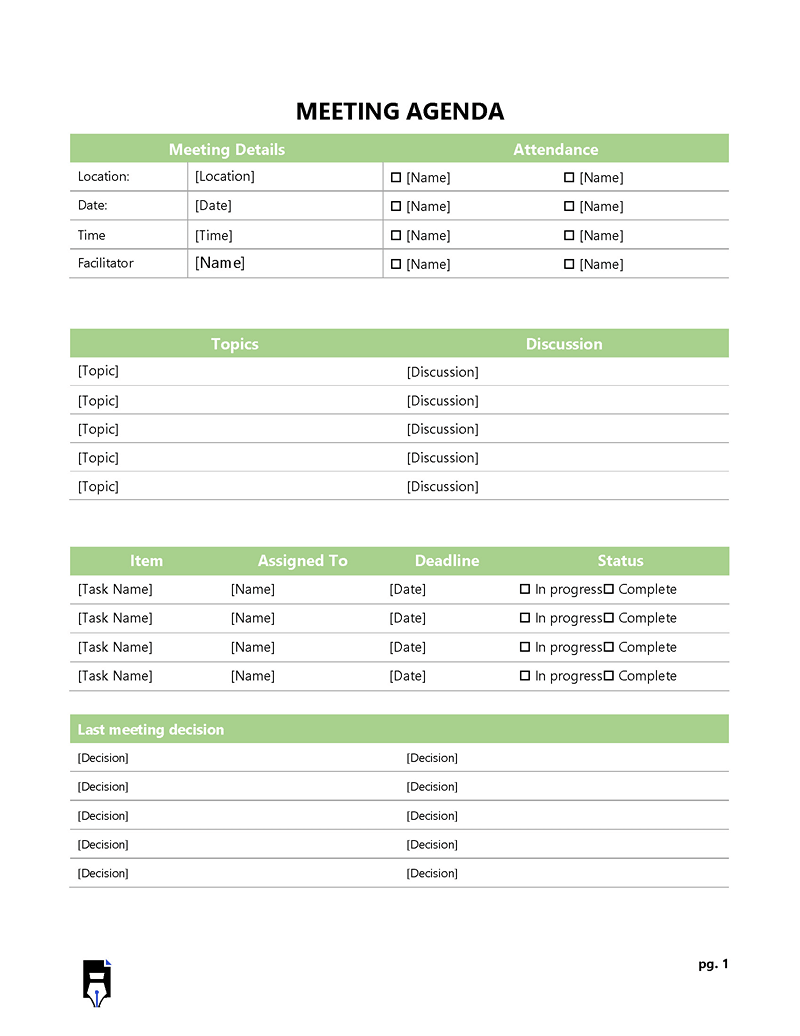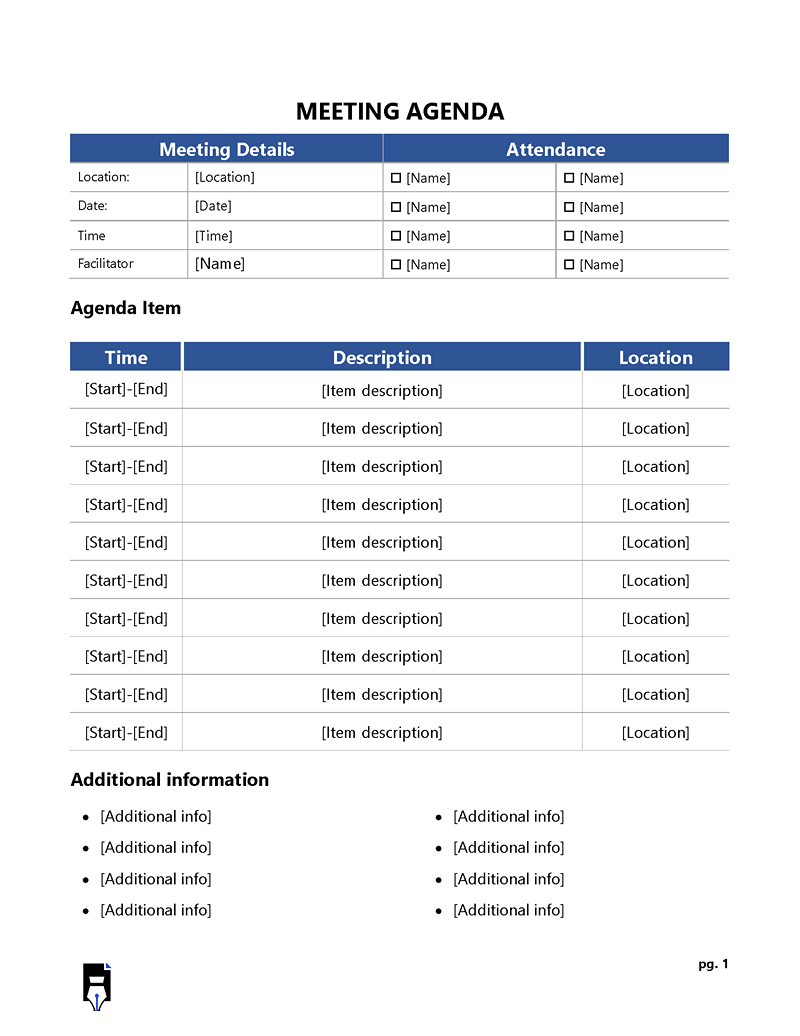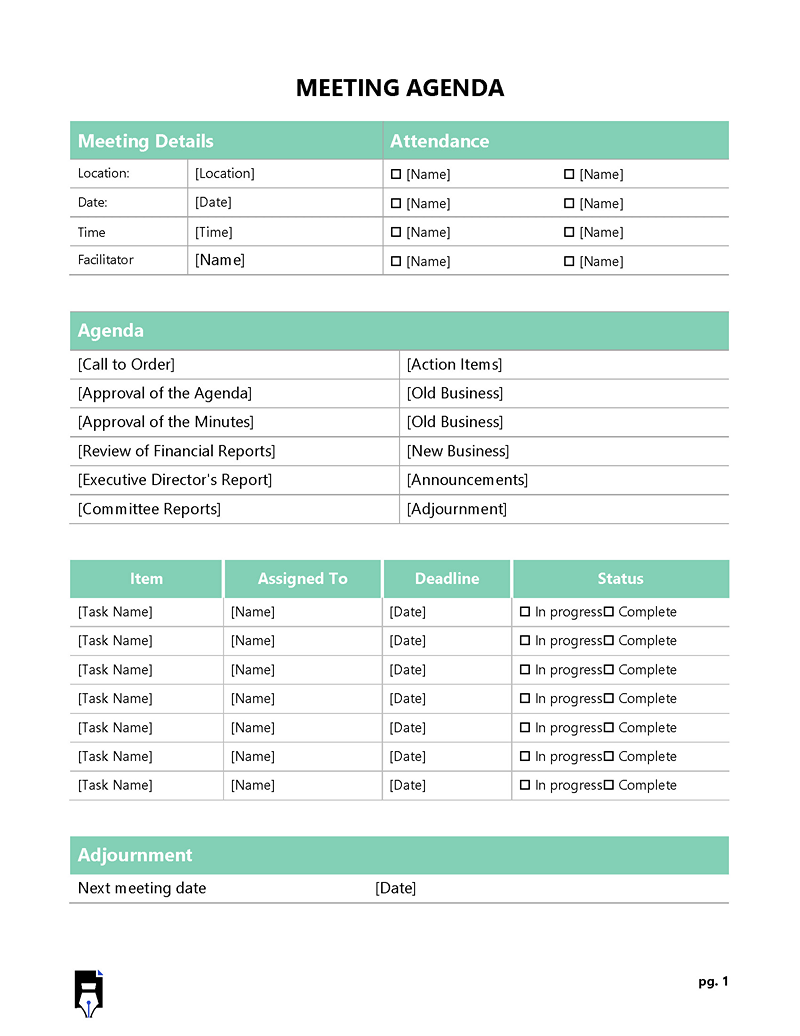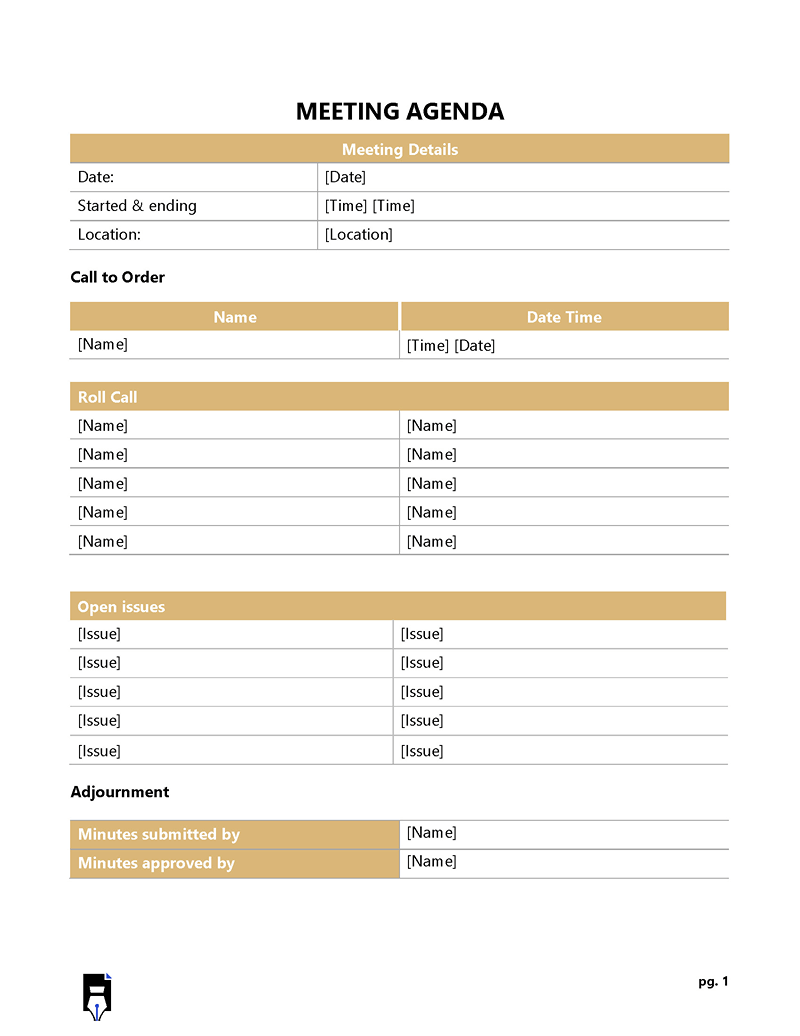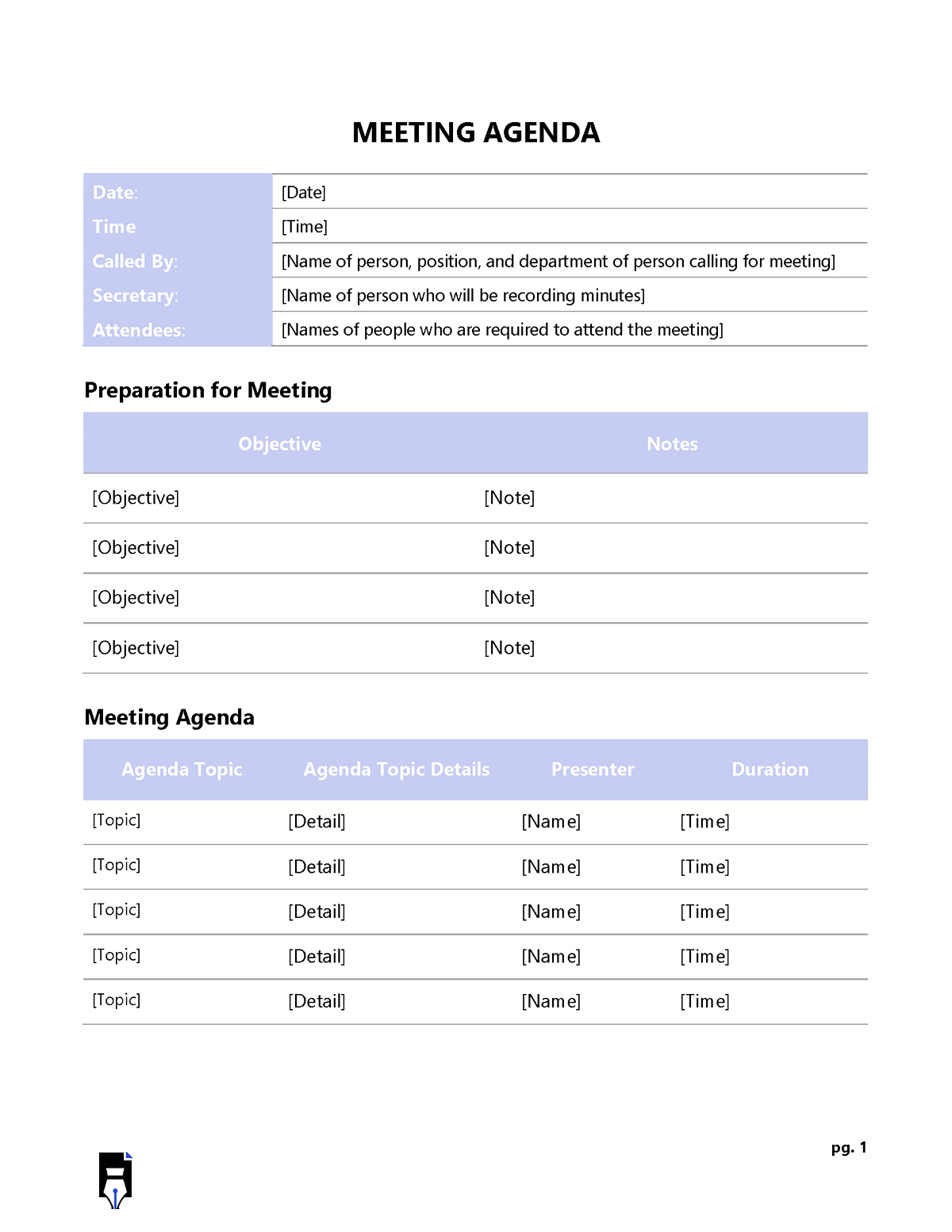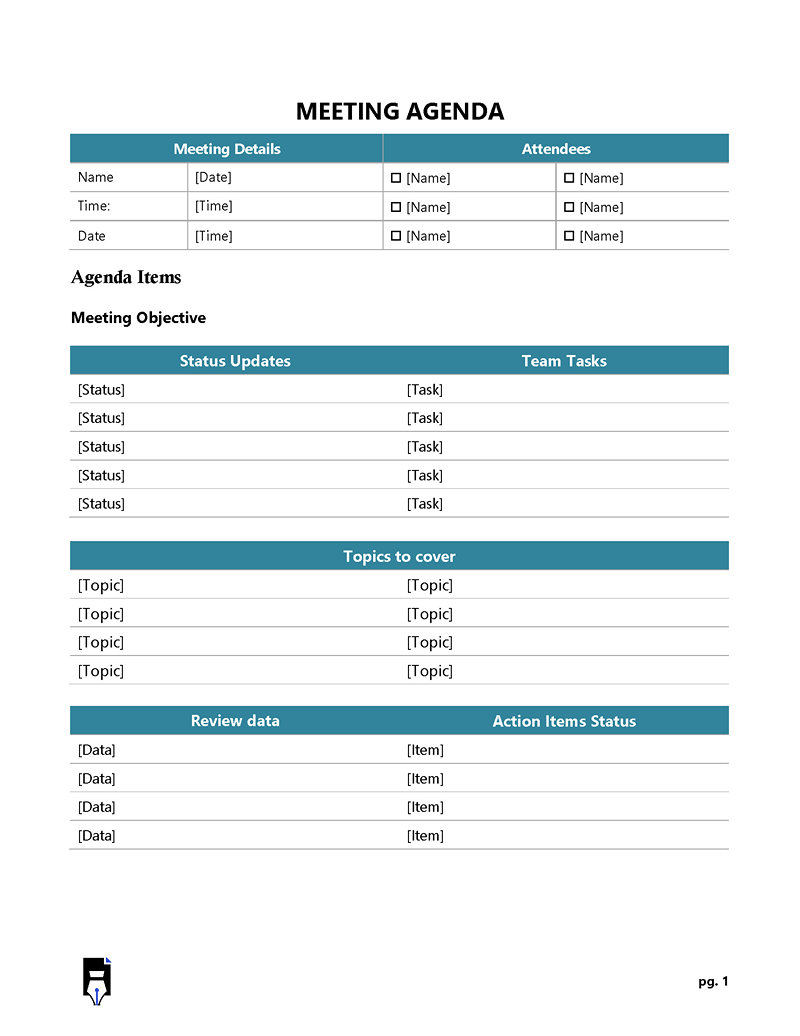Staff meetings are official gatherings when a firm or organization’s employees gather to discuss crucial issues and decisions about the business’s functioning. The staff meeting is one of the few times when the entire staff is gathered for internal discussions. In smaller organizations, a staff meeting might include every employee, whereas, in larger companies, the term is often used to describe a team meeting with someone’s immediate working group.
The meeting aims to create plans for upcoming projects and initiatives, discuss any issues or concerns, and ensure everyone is on the same page. This allows everyone to stay updated regarding what’s happening across other teams and departments. Thus, these meetings can be recurring, such as weekly or bi-weekly team meetings. They require precise agendas, so everyone can follow along and make valuable inputs to the topic of discussion.
A staff meeting agenda is a written list of the subjects covered during the meeting and the sequence in which they will be covered. Following staff meeting agendas ensures that the meeting stays on schedule and that all relevant topics and issues are covered.
This article will outline a comprehensive guide for developing useful staff meeting agendas. It will provide tips and best practices for creating agendas that promote participation and productivity throughout staff meetings. It also provides downloadable staff meeting agenda templates, whether for a small team or a large organization
Download Free Templates
Given below are staff meeting agenda templates:
Statistical Insight: Research indicates that 50% of all meetings are a waste of time. In fact, each employee spends about 31 hours in unproductive meetings over the course of one month. And here’s something else interesting; 91% of employees daydream during meetings, 73% do other work, 39% sleep, and 45% complain about the number of meetings they attend. The sad news is that unproductive meetings are also expensive, costing US businesses $37 billion yearly. This is where it worsens: remote work increases employees’ time in meetings. This highlights the vital need for staff meeting agendas to ensure maximum productivity.
Purpose of Using a Staff Meeting Agenda
Agendas help guide staff meetings and ensure all necessary topics are covered and discussed promptly. A report from Reclaim.ai shows that employees now spend 25.3% more time in meetings compared to pre-pandemic times. However, the rising cost of unproductive meetings has made staff meetings more important than ever.
The following are several purposes of a staff meeting agenda:
- Agendas help the team stay focused on a particular task. A common goal or meeting outcome ensures everyone is on the same page.
- Agendas can help take minutes to ensure no information is missed and summarize the meeting at the end. A successful meeting agenda increases team accountability and engagement and enables innovative problem-solving.
- Meeting agendas help keep a close track of a project’s progress. They help review how the team tracks against its goals and allow the team to share important updates on ongoing projects. They also help highlight challenges so the team can collectively develop the best solutions.
- Formulating meeting agendas helps the team focus and give valuable input on a project or challenge. They are valuable tools that allow the team to brainstorm ideas, projects, or campaigns, enabling innovative problem-solving.
- A staff meeting agenda plays a role in acknowledging the contributions of individual team members. They set the perfect scene in team meetings to recognize particular team members who deserve praise for their contributions and hard work on specific tasks and achievements. This keeps the team’s productivity alive.
- Agendas help manage time by organizing the meeting into separate topics and allocating specific time for each topic. This prevents the meeting from getting off track, allowing the team to discuss the most crucial points promptly. Effective agendas result in meetings with tangible results, i.e., a decision, plan, list of ideas, or shared understanding of the work ahead.
How to Plan a Staff Meeting Agenda: Step-by-Step Guide
Any team or organization must have effective communication and collaboration to be successful. Regularly hosting staff meetings where team members can exchange information, address problems, and make choices is one strategy to promote these traits. However, a well-planned agenda is essential for a staff meeting to be successful.
This step-by-step guide will assist you in ensuring you develop and execute effective agendas that will keep staff meetings focused, effective, and productive:
Step 1: Determine meeting objectives and goals
It is essential to consider the meeting’s purpose and expected outcomes while setting its objectives and goals. For example, its purpose is to share information, brainstorm ideas, or propose a solution to a problem. Creating an objective clarifies why a meeting is being held and what the meeting seeks to accomplish.
Choose SMART (specific, measurable, achievable, relevant, and time-bound) objectives that support the mission. This is crucial because it ensures that the meeting stays on track and that the agenda successfully produces the desired results. Ensure that every team member is involved in identifying and setting the goals of the meeting for maximum coverage and collective team engagement during the meeting.
Step 2: Prepare and reuse a meeting template
Using agenda templates in advance to ensure that staff meetings run smoothly and have positive outcomes is wise and time-saving. You can outline the meeting’s agenda, objectives, and expected outcomes by creating a template you can share with the team. This ensures more efficient use of time since everyone can arrive prepared with the information and resources required to discuss the items on the agenda. These templates are helpful because they allow you to participate fully in the meeting while noting important information, making your work easier.
Step 3: List and organize agenda items
Listing agenda items is crucial when creating a meeting agenda since it ensures that all critical issues are covered. A concise and precise description of each item on the agenda should be included, along with the expected result or conclusion that will be reached during the discussion.
Some items that need to be listed include:
- The goal of the meeting
- Any necessary background information
- The precise subjects/topics the team will cover
- The names of the people who will be guiding the discussions for each topic
- Any particular instructions or rules for the meeting
In addition, it’s crucial to include any relevant files or material that attendees should review beforehand.
Tip: Be specific. Carefully consider which important issues and topics you should include on the meeting agenda. This clarifies the meeting’s goal and helps keep it focused and effective. Set aside time for each topic in accordance with its importance to ensure that the most pressing or necessary issues receive the appropriate consideration and that crucial decisions are made.
Step 4: Discuss priorities and goals for the upcoming week
When planning a staff meeting agenda, it is crucial that you allocate time to talk about the upcoming week’s aims and objectives. This helps the team set goals for discussion or review the report the following week. It also enables the team to review progress and make necessary adjustments to boost engagement and productivity. It further promotes collaboration and teamwork by keeping everyone updated on the status of the projects.
Step 5: Define a process for addressing each agenda item
Specifying a method for addressing each agenda item while creating a staff meeting’s agenda is crucial. This ensures that all important issues are covered and addressed during the session. It also helps keep the meeting structured and on schedule, preventing confusion and effort duplication. A defined process enables effective use of time and resources and creates avenues for better follow-up actions.
For instance:
If you are organizing a meeting to discuss organic traffic, the process of defining this agenda item can be comprised of; defining the problem (5 minutes), brainstorming the potential cause of the problem (10 minutes), proposing possible solutions (15 minutes), discussing, debating, and agreeing on the course of action (15 minutes).
Step 6: List participants
Your staff meeting agenda should have an updated list of attendees. This helps confirm that the right people are present for decision-making and contribution, enhancing efficiency and follow-up activities. A participation list is a reminder to all team members, prevents misunderstandings regarding who is anticipated to come, and records attendance for future use. If a team member does not add anything to the meeting, inviting them wastes their time and costs your company productivity. Assigning too many positions irrelevant to the topic results in less focused and successful meetings.
Step 7: Determine roles and assign responsibilities
When creating a staff meeting agenda, it is essential to give roles and duties to each team member. Doing so ensures that everyone knows what is expected of them during the meeting and that tasks and decisions are appropriately distributed. It enables better team communication, reduces confusion and duplication of work, and helps keep meetings on schedule and well-organized. Additionally, giving roles and tasks aids in increasing engagement, holding team members accountable, and ensuring that the meeting’s objectives are accomplished.
Step 8: Assign the next steps
Assigning the next steps to each team member in your team meeting agenda is essential because it ensures that action is taken after the meeting to accomplish the goals and decisions. It helps to give clear directions for future projects while also holding team members accountable and maintaining the team’s focus on the intended objective. Assigning the next steps makes monitoring progress easier, keeping the team on track and avoiding delays or procrastination in task completion, ensuring that the organization advances toward its goal.
Tips for Creating an Effective Meeting Agenda
Here are some pointers to help you create a useful and well-structured agenda for an upcoming staff meeting:
Establish a time limit for each topic
A staff meeting agenda must assign a time restriction for each topic. This is to help guarantee that the meeting continues on schedule and all the relevant subjects are covered within the allowed time. Additionally, it ensures that each topic receives adequate time, preventing any from requiring too much or too little, allowing the meeting to be effective and efficient.
Get everyone involved
It enables the integration of various viewpoints and ideas, resulting in a more thorough and well-rounded agenda that considers all team members’ demands and worries. As a result, decisions are made, and subsequent actions are taken more effectively. This also helps to increase involvement throughout the meeting.
Use verbs to inspire actions
This is advantageous since it helps make the agenda items precise, action-oriented, and understandable. Examples of such verbs include “share,” “Review,” “identify,” “recap,” and “discuss.” Using such verbs will make the meeting more effective and increases the likelihood that the meeting’s goal will be accomplished. It will also assist the team members in understanding what is expected of them during the meeting and what has to be done after it.
Organize agenda items by priority
Prioritizing the most important agenda topics guarantees that the most crucial issues are addressed first and receive the required time and attention before the rest. This enables the team to tackle the most significant tasks, giving the team flexibility if the meeting takes longer than the allocated timeslot. Prioritizing agenda topics also helps the team maintain focus and make the best use of available time.
Release your meeting agenda ahead of time
This enables team members to examine the agenda, be ready for the meeting, and make informed contributions. It allows team members to arrive at the meeting with a clear grasp of the subjects to be covered. Additionally, it enhances the likelihood that the meeting will begin on time and continue as planned.
Seek input/feedback
This enables more viewpoints and ideas to be considered and incorporated into the agenda, enhancing its comprehensiveness and diversity. It also aids in identifying any potential issues or concerns that may surface during the meeting and provides time to address them. Pose questions like, “Was the meeting objective clear enough?” “Were all the primary issues adequately covered in the meeting?” Getting feedback makes the subsequent meetings more successful, efficient, and aligned with the company’s objectives.
List agenda items as questions
In a staff meeting, posing agenda items as questions helps to focus the conversation and steer the group toward the intended goal. Questions help promote more active involvement and critical thinking. They also enable open and honest communication and encourage team members’ active participation, improving decision-making and problem-solving. For example, “What terms should we attach to the new clause to limit its misuse?”
Establish a consistent format
This ensures that the agenda is understandable, well-organized, and simple. It makes it simpler for team members to locate the required data, follow the meeting’s agenda, and keep track of important decisions and action items. It also increases the meeting’s general efficiency and effectiveness by maintaining order and timeliness.
Summary
When making a staff meeting agenda, it’s important to include all important topics and keep the meeting organized. As discussed, make a list of all the required items on the agenda, describe each item in detail, and specify the anticipated result or the decision that will be reached during the meeting. It is also crucial to use staff meeting agenda templates, which include time allocation for all agenda items according to their significance and considering time limits. Determining roles, duties, and next steps for each team member is also essential. A participation list and any relevant material or documents that attendees should check beforehand should also be included to allow the team to make informed decisions. Also, it is advisable to ask for feedback from the team after the meeting and to list issues as questions.
